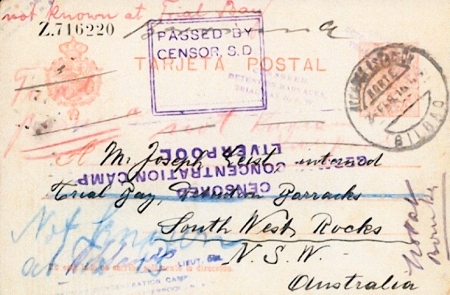At least 4 covers have appeared on several auction sites in the past 2 years, but illustrations were only available for two at the time for preparation of this paper. I knew little of the Australian internment camps during WW I in 1914-1918, and I had never heard of Trial Bay South West Rocks, N.S.W., so this paper was a great learning experience.
The first cover was sent from Ceylon on December 15, 1915 with a red 6 cents King George V stamp and was addressed to Reverend Father S. Simon, Trial Bay – P.O. South East (sic) Rocks, New South Wales, Australia and there was an indistinct purple hand stamp on the front of the cover (Figure 1).
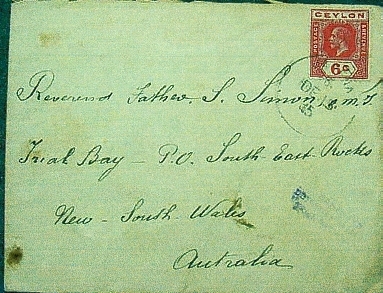
This indistinct 3-lined stamping on magnification read CENSORED/ DETENTION BARRACKS/ TRIAL BAY N.S.W. (Figure 2).

A second cover was described by the vendor as follows: “1916 POW Envelope to Germany on printed PRISONER OF WAR LETTER (in french) / FREE Indicium” and it had a purple boxed PASSED BY CENSOR marking plus a stamped signature which was illegible, but it is not the signature of the Camp Commandant who was a Captain J.K. Eaton in 1916. The address to Hamburg, Deutschland had been crossed out (Figure 3).

The flap of the cover was of considerable interest, for the sender’s name was stamped in purple as K. Wehle, with a manuscript ‘Detention Barracks, Trial Bay, N.S.W., Australien (Figure 4).
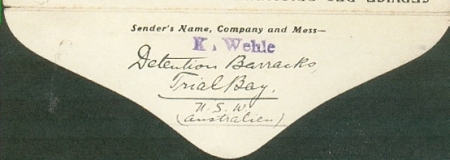
Two relevant additional covers were described on auction sites but not illustrated: One was from Bangkok, Thailand in 1916 with a 5 Satang on a 4 atts stationery card, sent to a German P.O.W. in Australia, with a boxed PASSED BY/CENSOR, S.D. plus the same 3-line CENSORED/ DETENTION BARRACKS/ TRIAL BAY N.S.W. marking.
Trial Bay, South West Rocks is at the estuary of the Macleay River on the N.S.W. north coast and it was named after the brig ‘Trial’, which was stolen by convicts in Sydney in 1816, and wrecked at the Bay during their attempted escape. The town of South West Rocks stands by the bay and the gaol at Trial Bay is of historical interest. It was started in 1886 by prison labour, but the first prisoners did not move in until 1886. The prison was closed in 1903, but opened again during the 1914-1918 war for German prisoners, and again closed after the war (Figure 5).
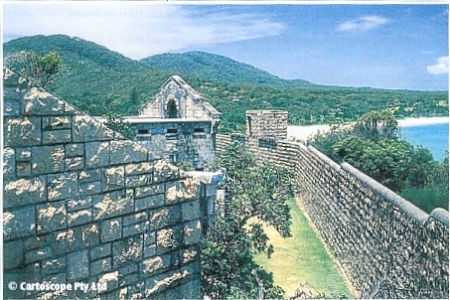
The Trial Bay camp (Detention Barracks) was situated in the gaol and it housed both German and Austrian internees (many of wealth, of social standing, such as consular officers, business men and other professionals). Included in this category of internees was Edmund Resch, the famous Sydney brewer, who had been in Australia for 50 years. Nearly two thirds of the internees had been residents of Australia prior to the war, some were naturalized British citizens, and some even second and third generation Australians of German origin. As well, prisoners of war brought from the Pacific Islands and British territories in South East Asia, plus sailors off German navy or merchant ships, were placed there. A total of 6,890 were interned at various Australian sites, and at its peak, the Trial Bay camp held 580 men. They were housed in the stone gaol cells or, those with higher ranks, in huts outside the gaol (Figure 6). The first group of internees at Trial Bay disembarked from the steamship S.S. Yulgilbar at the Jerseyville wharf, to march to the nearby Trial Bay gaol in August 1915 (Figure 7).
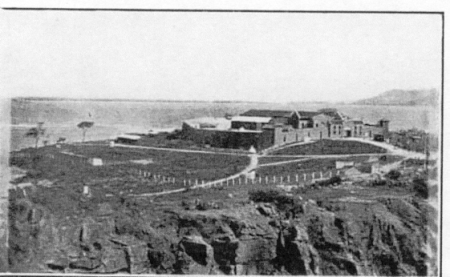
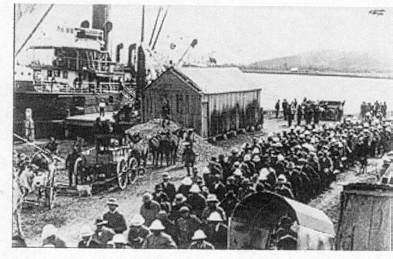
The inmates were under continuous guard, the mail was censored, and restrictions even cessation of newspapers, or transfer to other camps were used for infractions. At one stage the camp was inspected by the American Consul because of numerous complaints by the inmates. To fill their day, the men worked to run the gaol, they fished, swam, and played cards. They prepared their own weekly newspaper, ‘Welt am Montag’ (World on Monday) which started in 1917, and was financed through subscriptions and advertising! (Figure 8).
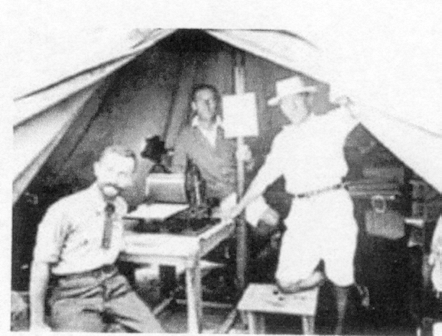
They put on many full-dress musicals, they had their own orchestra, and it is reported that they also played tennis, but the present cartoon almost certainly would have been a depiction of WW II internees’ tennis, for many Australians felt they were treated too well, as shown in Figure 9.
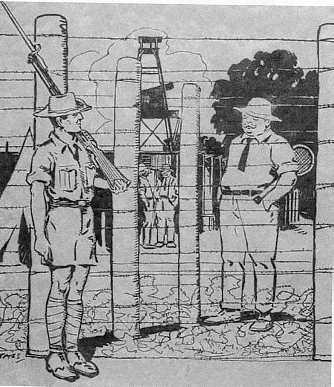
A relevant page of the Register of World War 1 Internees in New South Wales, 1914-1919 was provided by the National Archives of Australia which showed the entry for Karle Wehle, whose name appeared on the flap of Figure 4. His occupation was listed as a clerk, the date of his internment was 3.2.16 , he was interned from Hong Kong, his nationality was German and his release date was 29 May 1919. Under the list’s heading of ‘Company and Mess’ he was described as being in the ‘Kursk’ mess. On a page of 22 internees, the majority were seamen but the list also included a chemist, engineer, merchant, planter, watchmaker and a wool buyer.
After a threat of a German landing party arriving at Trial Bay to release the internees was received, Australian authorities felt it was wise to move the men inland to Holsworthy camp at Liverpool, so the Trial Bay camp was closed in 1918. The gaol now houses a museum that covers the history of the gaol and internment camp.
The vast majority of the above information was provided by Jenny Norberry of the Australian War Memorial in Canberra, in the form of digitised official records held at the National Archives website. I can’t thank her too much for her research efforts on my behalf.
Addendum: More than a year after this paper was written, another Trial Bay cover appeared on an Australian Auction site. It was described as a “1916 (Feb. 3) Spanish 10c Postal Card to a civilian internee at Trial Bay Detention Barracks/ South West Rocks/ NSW redirected several times, with mss “Not known/at TB”, in blue & “not known at Trial Bay” in red, “Try Berrima” in red & “(not known at) Berrima”, “not known Liverpool” in red &”Not at/ Bourke”. The several handstamps include a partial strike of the rare “CENSORED/ DETENTION BARRACKS/ TRIAL BAY NSW (Emery CM45) & very fine strike of a similar h/s but with seriffed letters (unrecorded by Emery). Still the only postal item we have seen that is relevant to the tiny POW Camp at Bourke in western NSW (Figure 10).
